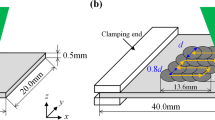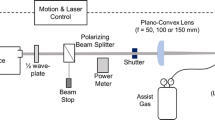Abstract
A technique of laser peen forming on a microscale has been developed, which does not require a confining (tamping) layer. This paper reports on the results of studies carried out on 75-μm-thick steel samples using pulsed Nd:YAG lasers operating at 1,064-, 532- and 355-nm wavelengths and relatively low beam powers of 5, 2.5 and 1.8 W, respectively. Empirical data are presented to demonstrate the active forming mechanism and to characterise the process. The process was found to produce a bending towards the laser beam at any angle of incidence, including at 0° (or parallel) to the surface. A bend angle of up to approximately 28° was possible when the incident angle is 90°. The process was found to be reversible by reverse side irradiation. The results from these experiments have been compared to samples formed using continuous wave thermal laser forming. The laser peen-formed samples do not show evidence of a heat-affected zone seen in thermal laser forming, which, together with thermocouple analysis, indicates that the active laser peen forming process is non-thermal.
Similar content being viewed by others
References
Namba Y (1985) Laser forming in space. Lasers ’85; Proceedings of the Eighth International Conference, Las Vegas, NV; 2–6 Dec, pp 403–407
Dearden G, Edwardson SP (2003) Some recent developments in two- and three-dimensional laser forming for macro and micro applications. J Opt A: Pure Appl Opt 5(4):S8–S15
Geiger M, Vollertsen F (1993) The mechanisms of laser forming. CIRP Ann 42(1):301–304
Magee J, Watkins KG, Steen WM (1998) Advances in laser forming. J Laser Appl 10(6):235–246
van Nielen KJ, Venstra WJ, Tichem M, Laros M, Sarro PM, Karpuschewski B (2002) Self-adjustment of optical interconnects using in-package MEMS-based actuators. Proceedings of the 16th European Conference on Solid State Transducers, September 15–18, Prague, Czech Republic, pp 794–797
Liu DM, Lu YF, Yuan Y, Wang WJ, Low TS, Wee TS, Chang KT, Goh JK (1999) Laser-induced deformation on hard disk surface. Appl Surf Sci 138–139:482–488
Dahotre NB (1998) Surface engineering series, vol 1—lasers in surface engineering. ASM International, Tennessee, p 465 ISBN: 0-87180-665-2
Yang LC (1974) Stress waves generated in thin metallic films by a Q-switched ruby laser. J Appl Phys 45(6):2601–2608
Fabbro R, Fournier J, Ballard P, Devaux D, Virmot L (1990) Physical study of laser-produced plasma in confined geometry. J Appl Phys 68:775–78410
Hosokai T, Kinoshita K (2003) Effect of a laser pre-pulse on a narrow-cone ejection of MeV electrons from a gas jet irradiated by an ultra short laser pulse. Phys Rev E67:036407
Kando M, Masuda S, Zhidkov A (2004) Electron acceleration by a nonlinear wake field generated by ultrashort (23-fs) high-peak-power laser pulses in plasma. Phys Rev E 71:015403.1–015403.4
Monttross CS, Wei T, Ye L, Clark G, Mai YW (2002) Laser shock processing and its effects on microstructure and properties of metal alloys: a review. Int J Fatigue 24:1021–1036
Al-Obaid YF (1995) Shot peening mechanics: experimental and theoretical analysis. Mech Mater 19:251–260
Peyre P, Fabbro R (1995) Laser shock processing: a review of the physics and applications. Opt Quantum Electron 27:1213–1229
Zhang W, Yao YL (2002) Micro scale laser shock processing of metallic components. J Manuf Sci Eng 124:369–378
Hackel LA, Chen HL (2003) Laser peening—a processing tool to strengthen metals or alloys to improve fatigue lifetime and retard stress-induced corrosion cracking. Laser Sci Technol 1058–1061
Chen H, Kysar JW, Yao YL (2004) Characterization of plastic deformation induced by micro scale laser shock peening. J Appl Mech 71:713–723
Fairland BP, Clauer AH (1976) Effect of water and paint coatings on the magnitude of laser-generated shocks. Opt Commun 18(4):588–591
Hong X, Wang S, Guo D, Wu H, Wang J, Dai Y, Xia X, Xie Y (1997) Confining medium and absorbing overlay: their effects on a laser-induced shock wave. Opt Lasers Eng 29:447–455
Masse JE, Barreau G (1995) Laser generation of stress waves in metal. Surf Coat Technol 70:231–234
Lengyel LL (1976) Effect of wavelength on absorption and ionization of laser produced plasmas in maganetic fields with allowance for finite-rate ionization and recombination. Plasma Phys 18:929–945
Noack J, Vogel A (1999) Laser-induced plasma formation in water at nanosecond to femtosecond time scales: calculations of thresholds, absorption coefficients and energy density. IEEE J Quantum Electron 35(8):1156–1167
Author information
Authors and Affiliations
Corresponding author
Rights and permissions
About this article
Cite this article
Edwards, K.R., Edwardson, S.P., Carey, C. et al. Laser micro peen forming without a tamping layer. Int J Adv Manuf Technol 47, 191–200 (2010). https://doi.org/10.1007/s00170-009-2185-6
Received:
Accepted:
Published:
Issue Date:
DOI: https://doi.org/10.1007/s00170-009-2185-6




